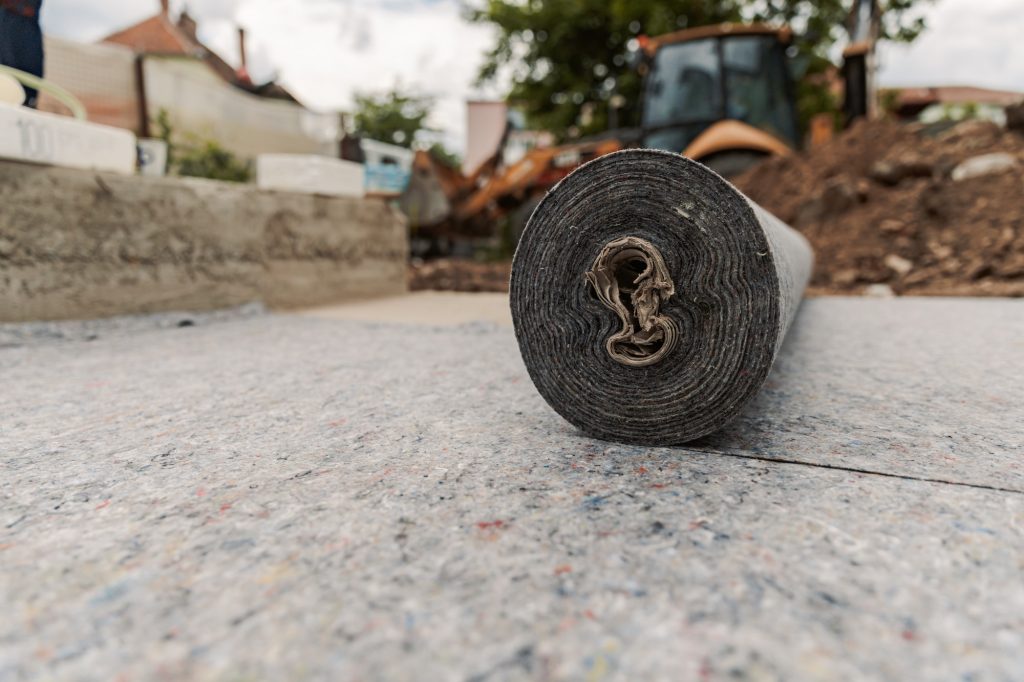Introduction to Roofing Underlayment
Roofing underlayment is a crucial component of any roofing system. A waterproof barrier is installed between the roof deck and the shingles or tiles. The purpose of roofing underlayment is to provide a secondary layer of protection against water and moisture.
Roofing underlayment is an essential aspect of a roofing system because it helps extend the roof’s life. It also helps to prevent leaks and moisture damage if shingles or tiles are damaged.

Types of Roofing Underlayment
Several types of roofing underlayment are available, each with unique properties and characteristics. The five main types of roofing underlayment are:
Asphalt-Saturated Felt
Asphalt-saturated felt is one of the most common types of roofing underlayment. It is made of a blend of organic felt fibres saturated with asphalt. This underlayment is typically used with other roofing materials, such as shingles or tiles.
Rubberized Asphalt
Rubberized asphalt is a roofing underlayment made from a blend of asphalt and synthetic rubber. This type of underlayment is known for its high resistance to water and moisture, making it an excellent choice for homes in areas with high levels of rainfall or snow.
Polypropylene
Polypropylene is a type of roofing underlayment that is made from synthetic plastic material. This type of underlayment is lightweight, durable, and resistant to moisture. It is also easy to install, making it a popular choice among homeowners and contractors.
Non-Bituminous Synthetic
Non-bituminous synthetic is a roofing underlayment made from a synthetic material that does not contain asphalt. This type of underlayment is known for its high moisture resistance and ability to provide excellent insulation. It is also lightweight and easy to install, making it a popular choice for many homeowners and contractors.
Peel-and-Stick
Peel-and-stick roofing underlayment is a type of underlayment made from a synthetic material covered with an adhesive layer. This type of underlayment is easy to install and provides excellent protection against moisture. It is also known for its high water resistance, making it a popular choice for homes in areas with high levels of rainfall or snow.
Comparison of Roofing Underlayment Types
Each roofing underlayment type has its unique set of pros and cons. Asphalt-saturated felt is known for its durability and affordability, but it is not as resistant to moisture as other types of underlayment. Rubberized asphalt is known for its high resistance to water and humidity, but it is also more expensive than different types of underlayment. Polypropylene is lightweight, durable, and easy to install, but it is not as resistant to moisture as other types of underlayment. Non-bituminous synthetic is known for its high resistance to humidity and excellent insulation, but it is also more expensive than different types of underlayment. Peel-and-stick is easy to install and provides excellent protection against moisture, but it is also more costly than other types of underlayment.
When choosing a type of roofing underlayment, it is essential to consider factors such as cost, climate and weather conditions, roof slope and ventilation, building codes and regulations, and personal preferences.
Uses of Roofing Underlayment
Roofing underlayment is used for several different purposes, including:
Waterproofing
Roofing underlayment provides an extra layer of protection against water and moisture, helping to prevent leaks and water damage.
Moisture Protection
Roofing underlayment helps to prevent moisture from seeping into the roof deck, helping to prevent mould, mildew, and other forms of moisture damage.
Improved Insulation
Roofing underlayment can help improve the roof’s insulation, helping to keep the home warm in the winter and cool in the summer.
Increased Durability
Roofing underlayment helps extend a roof’s life by providing an extra layer of protection against the elements.
Enhanced Soundproofing
Roofing underlayment can help to reduce noise transmission through the roof, helping to make a home quieter and more comfortable.
Choosing the Right Roofing Underlayment
When choosing a type of roofing underlayment, it is essential to consider several factors, including:
Climate and Weather Conditions
The climate and weather conditions in the area where a home is located will play a significant role in determining the type of roofing underlayment needed. For example, homes in areas with high levels of rainfall or snow may require a roofing underlayment that is highly resistant to water and moisture.
Roof Slope and Ventilation
The slope and ventilation of a roof will also play a role in determining the type of roofing underlayment needed. For example, homes with flat roofs may require a different kind of underlayment than homes with sloped ceilings.
Building Codes and Regulations
Building codes and regulations will also play a role in determining the type of roofing underlayment needed. It is essential to check with local building codes and regulations to ensure that the type of roofing underlayment used complies with local laws.
Personal Preferences and Budget
Finally, personal preferences and budget will also play a role in determining the type of roofing underlayment needed. Homeowners may prefer a specific type of underlayment for its appearance, performance, or durability, while others may choose a variety of underlayments based on cost.
Installing Roofing Underlayment
Installing roofing underlayment is a complex process that requires careful preparation and attention to detail. Following all manufacturer instructions and safety precautions when installing roofing underlayment is essential. Some of the steps involved in installing roofing underlayment include the following:
Preparation
Before installing roofing underlayment, it is essential to prepare the roof deck. This may involve repairing any damage to the roof deck, cleaning the roof deck, and ensuring that the roof deck is free of debris.
Steps for Installation
Once the roof deck is prepared, installing the roofing underlayment is next. This may involve laying down a layer of underlayment, securing it in place, and overlapping the edges to ensure a seamless and waterproof barrier.
Safety Precautions
When installing roofing underlayment, it is essential to take safety precautions to ensure the installation is performed safely and effectively. This may include wearing appropriate safety gear, such as a hard hat, gloves, and safety glasses, and protecting against falls and other accidents.
Maintenance of Roofing Underlayment
Roofing underlayment requires regular maintenance to ensure that it provides adequate protection against water and moisture. Some of the steps involved in maintaining roofing underlayment include:
Inspections
Regular inspections of the roofing underlayment are necessary to ensure it is in good condition and functioning correctly. This may involve checking for signs of damage, such as tears, holes, or other signs of wear and tear.
Repairs and Replacements
If damage to the roofing underlayment is found during an inspection, it may be necessary to perform repairs or replace it. This may involve patching holes, repairing tears, or replacing the underlayment.
Conclusion
Roofing underlayment is a crucial component of any roofing system, providing an extra layer of protection against water and moisture. Several types of roofing underlayment are available, each with unique properties and characteristics. When choosing a type of roofing underlayment, it is essential to consider factors such as climate and weather conditions, roof slope and ventilation, building codes and regulations, and personal preferences and budget. Installing roofing underlayment is a complex process that requires careful preparation and attention to detail, and regular maintenance is necessary to ensure that the underlayment continues to function correctly.
FAQs
- What is roofing underlayment? Roofing underlayment is a waterproof barrier between the roof deck and the shingles or tiles. It provides a secondary layer of protection against water and moisture.
- What are the different types of roofing underlayment? The five main types of roofing underlayment are asphalt-saturated felt, rubberized asphalt, polypropylene, non-bituminous synthetic, and peel-and-stick.
- What are the uses of roofing underlayment? Roofing underlayment is used for several purposes, including waterproofing, moisture protection, improved insulation, increased durability, and enhanced soundproofing.
- How do I choose the proper roofing underlayment for my home? When choosing a type of roofing underlayment, consider factors such as climate and weather conditions, roof slope and ventilation, building codes and regulations, and personal preferences and budget.
- How do I install roofing underlayment? Installing roofing underlayment is a complex process that requires careful preparation and attention to detail. Following all manufacturer instructions and safety precautions when installing roofing underlayment is essential. Some steps include preparing the roof deck, laying the underlayment, and securing it in place.
